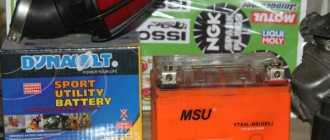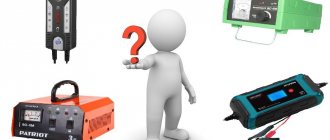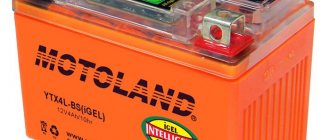The service life of a gel battery, according to manufacturers, is at least 10 years. In practice, the need to repair or replace it becomes obvious after 3-4 years, when a decrease in capacity is observed or the electrolyte solution dries out. The product belongs to the category of maintenance-free elements, but experienced vehicle owners know how to restore a gel battery at home.
Diagram: what parts does a gel battery consist of?
Fundamental differences between gel batteries
Such batteries differ from lead-acid analogues in a number of technical characteristics and electrolyte composition. The binding solution in it is distilled water with the addition of silica gel, which tightly seals the contents of the case.
This allows you to avoid chemical fumes, which affects the environmental friendliness of the device - it can be installed not only inside the car, but also in residential areas. In addition, due to the absence of gas emissions, their re-involvement in the work process is ensured and the service life of the product is increased.
Another advantage of the battery is the ability to place it in any position - on its side or upside down, while acid batteries need strictly vertical fixation.
Advantages of the gel battery design.
Batteries with gel electrolyte do not require deep recharging, charge quickly and maintain a service life in standby mode for 2 years.
Due to the increase in the number of charge-discharge cycles, more intensive use of such products is possible.
Among the negative features of such batteries are:
- Instability to low temperatures. At -50⁰C the electrolyte freezes and becomes brittle.
- Rapid failure when applying voltage above 15 V.
- High price.
Summary
Chemical sources of electric current, which include lead-acid, are in a state of constant improvement. Gel batteries are the next stage of this development. Gel batteries are ideal for use in transport on extreme or sports routes, for owners of powerful audio systems. They performed well at high current loads and have an impressive service life. If necessary, you can restore a tired gel battery by applying cyclic voltage.
How to check a gel battery
If there are no obvious flaws, the device is checked using a voltmeter and a load fork, simulating the operation of the starter for 3-4 seconds. The load is connected after setting the voltage values at the terminals, and then an improvised motor is connected for a short period.
The rate of recovery of the electromotive force is assessed by observing the voltmeter needle, which should rise back.
A rapid drop in current indicates that the battery has almost used up its resource; a new device takes a long time to charge. If no changes occur, the voltage can be increased by gradually adding 5 V. During the operation, you should pay attention to ensure that the temperature of the device does not exceed 40-45⁰C.
Our video from the partner training seminar. AGM and Gel technologies
Leave comments and ask questions!
Every car owner understands how important the power source in a car is. When the time comes to change it, many are faced with the fact that they do not know which battery is better to choose and what parameters to focus on. There are plenty of advertisements on the Internet, on TV and other sources, but choosing the perfect battery is not easy. We tried to collect all the useful information and consider the pros and cons of gel power sources in one article.
Is the gel recoverable?
The basis for battery restoration is the drying of moisture in the electrolyte. To check the liquid level in the cans, open the battery cover with a knife or other sharp instrument. When returning the cover to its original position, you must ensure that there is no dirt on the valves.
Because of this, they may not close, and the gel will dry out faster. In addition, the integrity of the device case and its contents is taken into account. The amount of charge stored in the battery must be at least 30% of the required value.
Basic rules for safe charging
The gel battery can be charged at home. The main thing is to ensure the supply of direct current. The procedure is carried out using a 12V charger, which is used only for gel devices.
You can make such chargers yourself. What distinguishes them from other products is the ability to control the incoming voltage. It is recommended to set this indicator at 0.1 of the battery power, the charging time will be about 12 hours. A device designed for acid-type devices cannot be used.
The battery is fully charged and is not used at a low energy level.
A long stay in a discharged state leads to a decrease in capacity. Regularly recharging the battery will prevent this situation.
Video
See how to restore the capacity of a gel battery with your own hands.
Gel batteries for cars have been produced relatively recently. As a result, as is the case with any new product, car enthusiasts still have many questions related to their maintenance and operation. And first of all, car owners are concerned about whether it is possible to restore gel batteries. In order to understand this issue, we will briefly describe the features of their design, the requirements of manufacturing companies for servicing gel batteries, and only after that we will consider ways to revive gel batteries produced by folk craftsmen.
How to restore a battery
The process of restoring a gel battery.
Gel batteries are more demanding to maintain, so refurbishing them requires great care. The following tools are used during the procedure:
- syringe;
- tweezers;
- screwdriver;
- Charger.
To restore electrolyte levels, you will need distilled water, which can be purchased at a pharmacy.
Filling distillate
The battery is disassembled by removing the top cover, after which the rubber valve caps are removed with tweezers. Then use a syringe to add 2 ml of distillate to each jar. The liquid must be added gradually as the water is absorbed into the gel. The restored level should completely cover the lead plates, and excess moisture is pumped out with the same syringe.
In some cases, instead of distilled water, electrolyte is poured into the battery. This will work if the battery is old and needs to be revived temporarily.
Recovery using long-term battery charging
After adding distilled liquid, the valves are returned to their place and closed with a lid, which is fixed with tape or glue, and a load is placed on top. This is necessary in order to prevent the valves from breaking due to the released gas.
When connecting the battery to the charger, set the voltmeter to 14-15 V and wait until the battery restores current consumption (within 14 hours). If this does not happen, the voltage is increased to 20 V.
It is important not to leave the battery unattended, since restoration of the electrolyte leads to a sharp drop in load and can cause smoke and burnout of the device. Therefore, as soon as current flows, the level of electromotive force is reduced to 14 V and the battery continues to be charged in the standard mode, i.e., with a charge equal to 0.1 of its nominal capacity.
Cyclic charging
The method is used for severe loss of capacity. It involves 3-4 repeating cycles of charging and discharging.
The first two are carried out under a high voltage of 25-30 V, which gradually decreases to 14 V as current consumption increases. For discharge, a 5-10 W light bulb is used, and care must be taken that the potential difference does not fall below 10, 5-11 V.
After recovery, the battery is charged in standard mode. If it is not possible to return full power to the battery, it is used with an incomplete charge or a new model is purchased.
Gel technology
The design of a gel battery is similar to AGM, but the electrolyte is not absorbed by glass fiber, but thickened with silica gel (SiO2). The gel retains the electrolyte in its structure, maintaining the integrity of the lead plates. The movement of electrolyte molecules occurs through the micropores of the gel structure.
Now let's compare the characteristics and cost of similar batteries made using different technologies. Based on data sheets (performance characteristics) and an interview with an engineer, we will compare the characteristics using the example of Delta and Challenger batteries.
1) Charge
The classic charge current for lead-acid batteries is 0.1C or 10% of the battery capacity, but the maximum permissible charge current for AGM and gel batteries is different:
- AGM – 0.3C (for example, for battery Delta HR 12-100 (100Ah) – charge current 30A)
- GEL – 0.2C (for battery Delta GX 12-100 (100Ah) – charge current 20A)
Charging with maximum current slightly reduces the battery life (by 5-7%), but can be very useful in cases where the battery needs to be charged quickly. For example, when working in hybrid systems with a generator. Thus, the minimum possible charging time (taking into account efficiency) for a completely depleted AGM battery will be about 6 hours, and for a GEL battery – 8 hours.
2) Number of cycles
Let's compare the number of cycles for different types of batteries in two different series
Delta HR 12-100 (AGM) : 100% DOD - 275 cycles, 50% - 575 cycles, 30% - 1325 cycles
Delta GX 12-100 (GEL): 100% – 325 cycles, 50% – 700 cycles, 30% – 1850 cycles
Delta DTM 12-200 L (AGM): 100% – 275 cycles, 50% – 550 cycles, 30% – 1200 cycles
Delta GX 12-200 (GEL): 100% – 325 cycles, 50% – 700 cycles, 30% – 1850 cycles
So, the difference in cyclicity between the HR (AGM) and GX (GEL) series at DOD 50% is 21.7% in favor of the latter; between DTM and GX: 27.2% in favor of the latter.
For objectivity, we present a graph and data on Challenger batteries series A (AGM) and G (GEL) at a discharge of up to 80%
Challenger A12-200 – 80% DOD – 525 cycles Challenger G12-200 – 80% DOD – 645 cycles 19% difference.
3) Current retail price and cycle cost
Due to the unstable exchange rate, I had to indicate in the hated dollars. In relation to the number of cycles at 50% discharge:
4) Deep discharge
Thanks to the use of an electrolyte thickener, a gel battery is more resistant to deep discharges, in other words, a discharge up to 1.6V/el (9.6V) causes less harm to the battery. Deep discharge of batteries is inherent in alternative energy (solar panels, wind turbines); in buffer modes, UPSs and inverters do not allow the battery to discharge below 10.5V.
5) Lifespan
The lifespan of a battery is a relatively abstract thing due to the fact that it is difficult and costly to conduct a professional study with parallel operation of a sample of two types of batteries from different series lasting 10-12 years and compare its results. The documentation indicates the same battery life. In view of this, we must rely on indirect data that is given to us by production engineers, whose opinion is based on the features of manufacturing technologies. So:
- DTM – standard AGM battery
- HR and HRL - differ in the composition of the electrolyte, to which special additives have been added, which increase energy output and slow down the process of sulfation and corrosion of the lead plates of the battery, significantly extending its service life
- Gel – electrolyte thickened with silica gel
Based on a survey of experts, the rating of the viability and timing of work in the buffer mode, from least to greatest, is built as follows:
- GX – a guide to cyclicality
- DTM L – Long Life additives
- HR – additives + high energy efficiency
How to extend the device's operating life
Application of GEL (Gelled Electrolite) and AGM (Absorptive Glass Mat) technologies for the need to maintain a gel battery.
The service life of a gel battery depends on the operating conditions and care of it. It is not recommended to allow the battery to completely discharge.
If this happens, use a limited charge replenishment scheme - not 10%, but 5% of the declared capacity - and double the process time. The loss of energy intensity during such actions is less than with the standard method.
To avoid such situations, you should purchase a multimeter. For preventive purposes, they regularly check the correct fastening of the terminals and perform a full battery charging cycle once a quarter.
In what cases is battery restoration inappropriate?
Batteries are disposed of:
- When the cans swell, which is caused by the detachment of the gel from the plates. Such a defect is determined visually.
- When the contents of the case are destroyed as a result of prolonged exposure to high temperature. If during inspection of the battery there are extraneous sounds coming from it, the element cannot be “revitalized”. You can also enlighten the holes of the cans and make sure that the lead plates have lost their original appearance.
The right decision in this case would be to buy a new gel battery.
mission Impossible
Unfortunately, or maybe, on the contrary, fortunately, there are times when it is not possible to restore a gel battery. One of these irreversible faults is when the electrolyte begins to peel off from the plates.
Or they may begin to break down. If this happens, then this also negates all attempts to revive the product. It is not difficult to detect such a malfunction - just shake the battery, and you can hear a noise coming from inside. The presence of a crack is also an unpleasant sign. How to restore a gel battery (12V) if available? The answer is simple: no way.










